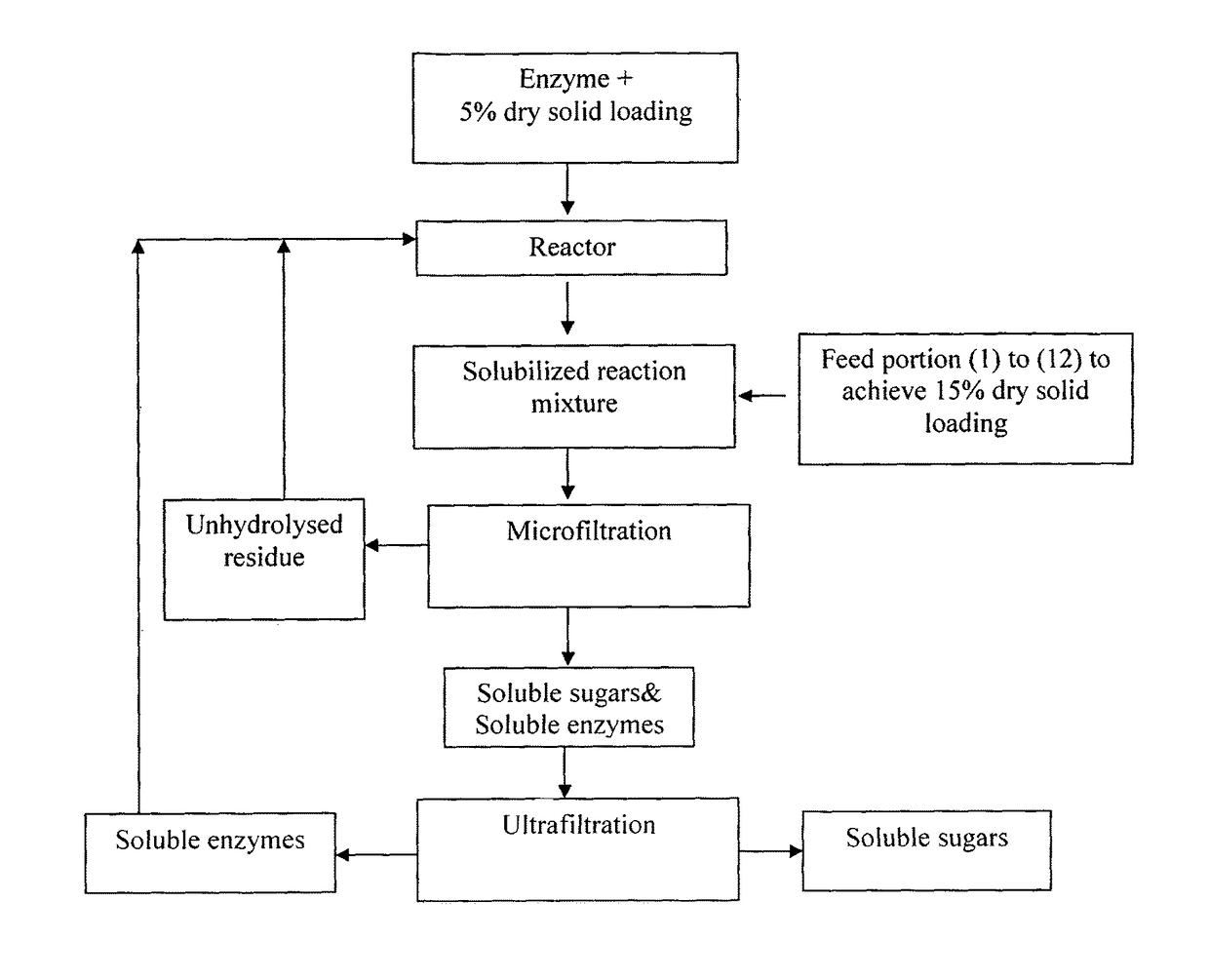Process for production of soluble sugars from biomass
a technology of biomass and soluble sugar, which is applied in the direction of biofuels, chemical recycling, fermentation, etc., can solve the problems of low product concentration, low reaction rate, and high cost of enzymes
- Summary
- Abstract
- Description
- Claims
- Application Information
AI Technical Summary
Benefits of technology
Problems solved by technology
Method used
Image
Examples
example 1
Saccharification of Biomass with Varying Cellulose Content
[0072]Pretreated biomass consisting of varying holocellulose content (70-95%) derived by acid / alkali treatment of wheat straw was solubilized in an enzyme solution maintained at 50° C. and pH of 5.0 with total dry solid loading of 15.0%. The initial heel consisting of 37.5 g of biomass on dry basis was mixed with an enzyme solution composed of Cellulase B™ (Advanced Enzyme Technology Ltd., Thane, India) and 750 gm of acidified water at a protein loading of 27.75 mg / g of biomass. The reaction mass was stirred at 300 rpm and temperature maintained to 50° C. and pH to 5.0. The remaining biomass was added gradually within 0.5-1.0 hr to increase the solid loading to 15%. The percentage of holocellulose solubilized was determined as reduction in dry weight of the total holocellulose added in the reaction and represented in terms of % solubilization as given below:
[0073]%Solubilization=Dryweightofunhydrolyzedholocellulose...
example 2
Saccharification of Biomass with Varying Biomass Loading
[0075]Pretreated biomass consisting of holocellulose content (70-95%) derived by acid / alkali treatment of wheat straw was solubilized in an enzyme solution maintained at 50° C. and pH of 5.0 with different total dry solid loading of 15.0%, 20.0% and 30.0%. The initial heel consisting of 37.5 g of biomass on dry basis was mixed with an enzyme solution composed of Cellulase B™ (Advanced Enzyme Technology Ltd., Thane, India) and 750 gm of acidified water at a protein loading of 27.75 mg / g of biomass. The reaction mass was stirred at 300 rpm and temperature maintained to 50° C. and pH to 5.0. The remaining biomass was added gradually within 0.5-1.0 hr to increase the solid loading to 15.0%, 20.0% and 30.0%. Percent solubilization was determined as mentioned earlier in Example 1.
[0076]
TABLE 2Saccharification of biomass with varying biomass loadingExampleBiomassHolocellulose%no.loadingcontentSolubilization215%95%71.50%20%95%58.13%30%...
example 3
Saccharification of Pretreated Biomass
[0077]Pretreated biomass derived by acid / alkali treatment of wheat straw was solubilized in an enzyme solution maintained at 50° C. and pH of 5.0 with total dry solid loading of 15%. The initial heel consisting of 37.5 g of biomass on dry basis was mixed with an enzyme solution composed of Cellulase B™ (Advanced Enzyme Technology Ltd., Thane, India) and 750 gm of acidified water at a protein loading of 27.75 mg / g of biomass. The reaction mass was stirred at 300 rpm and temperature maintained to 50° C. and pH to 5.0. The remaining biomass was added gradually within 0.5-1.0 hr to increase the solid loading to 15%. Percent solubilization was determined as mentioned earlier in Example 1.
[0078]
TABLE 3Saccharification of pretreated biomass by Cellulase BExampleBiomassBiomass%No.ComponentTypeEnzymepHSolubilization3CelluloseWheatCellulase5.073.14HolocelluloseStrawB62.14
PUM
| Property | Measurement | Unit |
|---|---|---|
| temperature | aaaaa | aaaaa |
| concentration | aaaaa | aaaaa |
| concentration | aaaaa | aaaaa |
Abstract
Description
Claims
Application Information
 Login to View More
Login to View More - R&D
- Intellectual Property
- Life Sciences
- Materials
- Tech Scout
- Unparalleled Data Quality
- Higher Quality Content
- 60% Fewer Hallucinations
Browse by: Latest US Patents, China's latest patents, Technical Efficacy Thesaurus, Application Domain, Technology Topic, Popular Technical Reports.
© 2025 PatSnap. All rights reserved.Legal|Privacy policy|Modern Slavery Act Transparency Statement|Sitemap|About US| Contact US: help@patsnap.com


